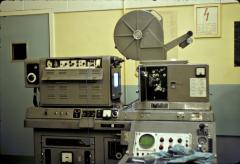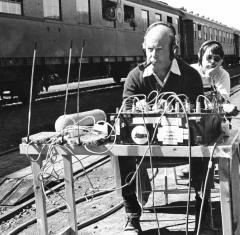-
Posts
347 -
Joined
-
Last visited
-
Days Won
4
Profile Information
-
Location
West Sussex, UK.
-
About
A varied career! Started off at BBC News at Alexandra Palace, then freelance working on BBC Nationwide, then features working with Peter Handford, then staff recordist for Southern Television and TVS, then freelance again. Now clapped out and otiose.
-
Interested in Sound for Picture
Yes
Recent Profile Visitors
The recent visitors block is disabled and is not being shown to other users.
-
When I was working (I am more than 15 years retired) everyone in film sound was using Beyerdynamic DT48s. I've got a pair hanging up next to me now! Quite expensive - they were abut £250 back then.
-
I was an assistant to Peter Handford who used radio microphones a lot in the period under discussion. The brand he favoured were the Audio Limited type, with Sony ECM 50s or the unbranded type supplied with the radio kits. I can't recall any radio problems with the radios themselves, but clothes rustle was a constant problem, usually solved with lots of gaffer tape. This usually resulted in painful removal for make actors, and sometimes embarrassing and intimate encounters with females! We found very early on the no actor could be trusted with placing their own mic. The other way of using radio mics was to plant them out of sight in the area that the boom couldn't cover. Murder on the Orient Express (the Albert Finney one) was a great place for this, with ECM 50s and radios stuck behind train seats. We used up to six radio mics at a time and they kept the sound crew busy, with gaffer tape coming loose, or the actors scratching themselves. Quite honestly, radio mics were a great pain for all concerned and only resorted to as a last resort. But we were very grateful that they were there as a fall back option. I can remember Peter telling me of an incident before radios mics - the actor had to carry an STC Ball & Biscuit mic to catch his lines as he walked swiftly along, with the Sound Maintenance man anxiously paying out the cable!
-
I used such a Stellavox once, and I thought that, compared with a Nagra, it was rather flimsy and not as robust. Very clever, but not quite butch enough!
-
Quite right - I was wrong to refer to the unit as an ATN-ATU: it is a PAR. It is so long since I used one that my memory failed. I'll just go out into the snow and shoot myself - I may be some time!
-
When I was working as 3rd or 4th man on sound crews in the late 1960s we used Nagra IIIs, Nagra IV-Ls and then Nagra 4.2s, eventually changing to IV-Ss for twin track recording. If I remember correctly, the ATN was used to power the machines off mains (in the UK 240 volts at 50Hz), and the ATN-ATU was used to charge rechargeable batteries within the Nagra - different pins on the socket on the Nagra if I remember correctly. I found that when operating off batteries, which was most of the time, except in studios, rechargeable batteries would not last as long between charges as ordinary HP2 batteries would before needing to be replaced.
-
For what it is worth, I found that letters (emails now) and threats of legal action didn't work - but going round to the production office and seeing the person who controls the finance sometimes does. People who are very brave and dismissive on a phone can be quite timid face to face with you. But always be polite - firm but polite.
-
My first feature film involved powering the camera (Mitchell BNC) off a rotary converter, which supplied a 50Hz pulse for the Nagra as well. I suppose the rotaries have been consigned to history books, but I was glad to have had experience with them. Here is the Wiki page that describes them: https://en.wikipedia.org/wiki/Rotary_converter The one I used for film work had a couple of beefy 12 volt lorry batteries as the power source, which powered a DC motor. This turned a three phase alternator which supplied the energy to power the camera motor. I assume that the rotary supplied 110 volts (I can't remember) for the American Mitchell; but the pulse for the Nagra was 50Hz.. There was an automatic system for keeping the machine at the right speed, which varied with load, although there was also a knob for manual regulation; and the frequency of the pulse was displayed on a reed meter, which vibrated a bank of reeds, each carefully cut to the right length to vibrate most at its indicated frequency, with 50Hz in the middle and + or - 0.1 Hz on either side.I expect that in the USA this would have been 60Hz. In a studio, this three phase power supply would have been available off the wall boxes, but we were shooting in a disused factory, so it was location equipment. Nevertheless, it took two men to shift the box containing the equipment. The operation of the rotary guaranteed the four man sound crew: the sound maintenance guy watched over the rotary, the sound camera operator would operate the Nagra (only a few years previously he would have operated a Sound Camera), the boom op swung the boom (Fisher or Mole) and the mixer twiddled the knobs. Four man sound crew. Luxury! The sequence of events when shooting would be for the 1st Assistant to shout "Turn over," and the rotary would be switched on. After about 4 or 5 seconds it would have got up to speed and stabilised, and the operator would call out "Speed", and the board would go on. There were other way of getting the 3 phase supply on location, using big capacitors, but these were unmanned and therefore of little interest.
- 1 reply
-
- 2
-

-
I used Beyer DT48s and nothing else. Although other makes and models may have been superior, I was used to the the DT48s and I think that is important. Get really familiar with one kind of headphone and you unconsciously compensate for their drawbacks, if any.
-
Just listened to this. It gave me much pleasure to hear the music and to see the microphones. Fairest isle, all isles excelling, Seat of pleasure and of love. Venus here will choose her dwelling, And forsake her Cyprian grove. Cupid from his fav'rite nation Care and envy will remove; Jealousy that poisons passion, And despair that dies for love. Gentle murmurs, sweet complaining, Sighs that blow the fire of love, Soft repulses, kind disdaining, Shall be all the pains you prove. Every swain shall pay his duty, Grateful every man shall prove; And as these excel in beauty, Those shall be renown'd for love.
-
Keith's response to Philip's comments: The position of the clamp was worked out right at the beginning in 2002 and it was decided to put the clamp so that the weight of the boom being heavier at the front, would tighten the clamp rather than loosen it irrespective of whether it was on the left or the right. Also the clamp has a reinforced fibre/rubber washer which interacts with the ridges within the circular base forming something like a click stop mechanism. The boom stays within the cradle without the need to have a clamp to keep it in place and simply holding it when repositioning the boom is adequate. He obviously looked at the pics and thinks the handle will come loose. It’s the cradle which has a square hole for the clamping bolt and the washer is fixed to it so if anything would move it would be the cradle thus tightening!
-
Thanks Philip. I will pass these suggestions onto the manufacturer. Nick.
-
These items, made by my friend Keith in Wales, may be of interest. http://www.boom-buddy.com/
-
Best options for minimizing clothing rustles on lav mics?
Nick Flowers replied to Thomas Farmer's topic in Equipment
Absolutely right! But I am also reminded of a comment I once heard uttered by a sound mixer: "Well, this shot's impossible: what's next?"

.png.279748a58a2b862b7aa5f3b84126e232.png)

.jpg.3b3805e78ff8691f49c086532283adde.jpg)





